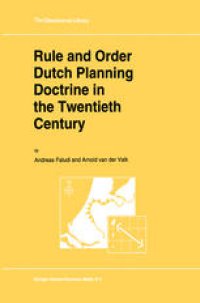
Ebook: Rule and Order Dutch Planning Doctrine in the Twentieth Century
- Tags: Environmental Management, Political Science general, Regional/Spatial Science, Human Geography
- Series: The GeoJournal Library 28
- Year: 1994
- Publisher: Springer Netherlands
- Edition: 1
- Language: English
- pdf
This book is about an art in which the Netherlands excels: strategic planning. Foreign observers will need little convincing of the merits of Dutch planning. They will want to know whether routine explanations (small country, industrious, disciplined people hardened by the perennial fight against the sea) hold any water, and they will want to know where to look for the bag of tricks of Dutch planners. Dutch readers need to be convinced first that planning in the Netherlands is indeed effective before contemplating how this has come about. Our message for both is that, to the extent that Dutch planners do live in what others are inclined to see as a planners' paradise, it is a paradise carefully constructed and maintained by the planners themselves. This smacks of Bernard Shaw describing a profession as a conspiracy against laity. However, all knowledge and all technologies are 'socially constructed', meaning that they are the products of people or groups pursuing often conflicting aims and coming to arrangements about what is to pass as 'true' and 'good'. So this takes away the odium of Dutch planners having their own agenda. Positioning ourselves We are in the business of interpreting Dutch planning, and at the same time committed to improving it. This makes us part of the situation which we describe. This situation is characterized by the existence of two divergent traditions, urban design and the social-science discipline called 'planologie'.
This book is about Dutch strategic planning. Although the Netherlands is often considered a planner's paradise, it should be realized that it is one that is carefully constructed and maintained by the planners themselves. In discussing national planning, and in this framework provincial and local planning, the authors invoke the notion of planning doctrine. Planning doctrine encompasses a definitive view of what the country should look like. In the Dutch case this entails preserving a distinct pattern of urban settlements called `Randstad' enclosing the open area in the middle called the `Green Heart'. Doctrine also addresses how government should pursue its policies in the face of mounting pressure.
By means of the `planning doctrine' planners are stimulating public support. This book comprises the origin and establishment of the `doctrine' up to and including the Fourth Report on National Physical Planning.
This book will be of interest to scientists, researchers and practitioners in urban, regional and strategic planning, urban and social history, social geography, public administration and policy sciences.